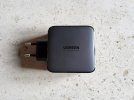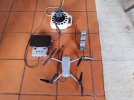Yes!!!
That is the fundamental advantage of PD.
You no longer need to be concerned with voltages, physical connectors, etc. Plug any USB-C PD source into any USB-C PD sink, and it will charge it.
The sink queries the source to find out it's capabilities (voltages available and max current that can be drawn at each voltage).
Then, the sink decides what voltage to request, and controls the power draw to stay within the capability of the charger.
So, plug the
A3 with battery inserted into a 24W PD charger and it will probably advertise 5V/2.5A 9V/2A and 12V/2A (fiction, but a typical power spec for a 24W source). The drone will send a message back selecting 12V, draw 2A, and charge at 24W. This charger will take 4-5 hours to charge one battery.
Contrast that with the DJI 65W charger, which has this profile:
5 V, 5 A
9 V, 5 A
12 V, 5 A
15 V, 4.3 A
20 V, 3.25 A
5-20 V, 3.25 A
With that charger, the drone will request 20V, and draw the full 3.25A, charging the battery in 80 minutes (for roughly the second half the drone is ramping down the current – and power – it draws due to the CCCV lithium-ion charge profile... google it).
If the 100W charger is used, the drone will draw 5A @20V for about 30min, then ramping down for the next 30m fully charging a depleted battery in about 60min.
With PD, chargers and devices are "smart", aware of power and voltage options, and negotiate to find the best electrical spec to use given device need and supply capability.













